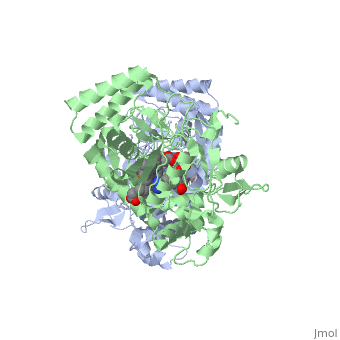2g6h: Difference between revisions
No edit summary |
No edit summary |
||
| Line 1: | Line 1: | ||
==Structure of rat nNOS heme domain (BH4 bound) in the reduced form== | ==Structure of rat nNOS heme domain (BH4 bound) in the reduced form== | ||
<StructureSection load='2g6h' size='340' side='right' caption='[[2g6h]], [[Resolution|resolution]] 2.00Å' scene=''> | <StructureSection load='2g6h' size='340' side='right'caption='[[2g6h]], [[Resolution|resolution]] 2.00Å' scene=''> | ||
== Structural highlights == | == Structural highlights == | ||
<table><tr><td colspan='2'>[[2g6h]] is a 2 chain structure with sequence from [ | <table><tr><td colspan='2'>[[2g6h]] is a 2 chain structure with sequence from [https://en.wikipedia.org/wiki/Buffalo_rat Buffalo rat]. Full crystallographic information is available from [http://oca.weizmann.ac.il/oca-bin/ocashort?id=2G6H OCA]. For a <b>guided tour on the structure components</b> use [https://proteopedia.org/fgij/fg.htm?mol=2G6H FirstGlance]. <br> | ||
</td></tr><tr id='ligand'><td class="sblockLbl"><b>[[Ligand|Ligands:]]</b></td><td class="sblockDat"><scene name='pdbligand=ACT:ACETATE+ION'>ACT</scene>, <scene name='pdbligand=ARG:ARGININE'>ARG</scene>, <scene name='pdbligand=H4B:5,6,7,8-TETRAHYDROBIOPTERIN'>H4B</scene>, <scene name='pdbligand=HEM:PROTOPORPHYRIN+IX+CONTAINING+FE'>HEM</scene>, <scene name='pdbligand=ZN:ZINC+ION'>ZN</scene></td></tr> | </td></tr><tr id='ligand'><td class="sblockLbl"><b>[[Ligand|Ligands:]]</b></td><td class="sblockDat" id="ligandDat"><scene name='pdbligand=ACT:ACETATE+ION'>ACT</scene>, <scene name='pdbligand=ARG:ARGININE'>ARG</scene>, <scene name='pdbligand=H4B:5,6,7,8-TETRAHYDROBIOPTERIN'>H4B</scene>, <scene name='pdbligand=HEM:PROTOPORPHYRIN+IX+CONTAINING+FE'>HEM</scene>, <scene name='pdbligand=ZN:ZINC+ION'>ZN</scene></td></tr> | ||
<tr id='gene'><td class="sblockLbl"><b>[[Gene|Gene:]]</b></td><td class="sblockDat">Nos1, Bnos ([ | <tr id='gene'><td class="sblockLbl"><b>[[Gene|Gene:]]</b></td><td class="sblockDat">Nos1, Bnos ([https://www.ncbi.nlm.nih.gov/Taxonomy/Browser/wwwtax.cgi?mode=Info&srchmode=5&id=10116 Buffalo rat])</td></tr> | ||
<tr id='activity'><td class="sblockLbl"><b>Activity:</b></td><td class="sblockDat"><span class='plainlinks'>[ | <tr id='activity'><td class="sblockLbl"><b>Activity:</b></td><td class="sblockDat"><span class='plainlinks'>[https://en.wikipedia.org/wiki/Nitric-oxide_synthase_(NADPH_dependent) Nitric-oxide synthase (NADPH dependent)], with EC number [https://www.brenda-enzymes.info/php/result_flat.php4?ecno=1.14.13.39 1.14.13.39] </span></td></tr> | ||
<tr id='resources'><td class="sblockLbl"><b>Resources:</b></td><td class="sblockDat"><span class='plainlinks'>[ | <tr id='resources'><td class="sblockLbl"><b>Resources:</b></td><td class="sblockDat"><span class='plainlinks'>[https://proteopedia.org/fgij/fg.htm?mol=2g6h FirstGlance], [http://oca.weizmann.ac.il/oca-bin/ocaids?id=2g6h OCA], [https://pdbe.org/2g6h PDBe], [https://www.rcsb.org/pdb/explore.do?structureId=2g6h RCSB], [https://www.ebi.ac.uk/pdbsum/2g6h PDBsum], [https://prosat.h-its.org/prosat/prosatexe?pdbcode=2g6h ProSAT]</span></td></tr> | ||
</table> | </table> | ||
== Function == | == Function == | ||
[[ | [[https://www.uniprot.org/uniprot/NOS1_RAT NOS1_RAT]] Produces nitric oxide (NO) which is a messenger molecule with diverse functions throughout the body. In the brain and peripheral nervous system, NO displays many properties of a neurotransmitter. Inhibitory transmitter for non-adrenergic and non-cholinergic nerves in the colorectum. Probably has nitrosylase activity and mediates cysteine S-nitrosylation of cytoplasmic target proteins such SRR. Inhibitory transmitter for non-adrenergic and non-cholinergic nerves in the colorectum. | ||
== Evolutionary Conservation == | == Evolutionary Conservation == | ||
[[Image:Consurf_key_small.gif|200px|right]] | [[Image:Consurf_key_small.gif|200px|right]] | ||
| Line 33: | Line 33: | ||
==See Also== | ==See Also== | ||
*[[Nitric Oxide Synthase|Nitric Oxide Synthase]] | *[[Nitric Oxide Synthase|Nitric Oxide Synthase]] | ||
*[[Nitric Oxide Synthase 3D structures|Nitric Oxide Synthase 3D structures]] | |||
== References == | == References == | ||
<references/> | <references/> | ||
| Line 38: | Line 39: | ||
</StructureSection> | </StructureSection> | ||
[[Category: Buffalo rat]] | [[Category: Buffalo rat]] | ||
[[Category: Large Structures]] | |||
[[Category: Igarashi, J]] | [[Category: Igarashi, J]] | ||
[[Category: Jamal, J]] | [[Category: Jamal, J]] | ||
Revision as of 21:48, 10 March 2021
Structure of rat nNOS heme domain (BH4 bound) in the reduced formStructure of rat nNOS heme domain (BH4 bound) in the reduced form
Structural highlights
Function[NOS1_RAT] Produces nitric oxide (NO) which is a messenger molecule with diverse functions throughout the body. In the brain and peripheral nervous system, NO displays many properties of a neurotransmitter. Inhibitory transmitter for non-adrenergic and non-cholinergic nerves in the colorectum. Probably has nitrosylase activity and mediates cysteine S-nitrosylation of cytoplasmic target proteins such SRR. Inhibitory transmitter for non-adrenergic and non-cholinergic nerves in the colorectum. Evolutionary Conservation Check, as determined by ConSurfDB. You may read the explanation of the method and the full data available from ConSurf. Publication Abstract from PubMedCrystal structures are reported for the endothelial nitric oxide synthase (eNOS)-arginine-CO ternary complex as well as the neuronal nitric oxide synthase (nNOS) heme domain complexed with L: -arginine and diatomic ligands, CO or NO, in the presence of the native cofactor, tetrahydrobiopterin, or its oxidized analogs, dihydrobiopterin and 4-aminobiopterin. The nature of the biopterin has no influence on the diatomic ligand binding. The binding geometries of diatomic ligands to nitric oxide synthase (NOS) follow the {MXY}(n) formalism developed from the inorganic diatomic-metal complexes. The structures reveal some subtle structural differences between eNOS and nNOS when CO is bound to the heme which correlate well with the differences in CO stretching frequencies observed by resonance Raman techniques. The detailed hydrogen-bonding geometries depicted in the active site of nNOS structures indicate that it is the ordered active-site water molecule rather than the substrate itself that would most likely serve as a direct proton donor to the diatomic ligands (CO, NO, as well as O(2)) bound to the heme. This has important implications for the oxygen activation mechanism critical to NOS catalysis. Structural studies of constitutive nitric oxide synthases with diatomic ligands bound.,Li H, Igarashi J, Jamal J, Yang W, Poulos TL J Biol Inorg Chem. 2006 Sep;11(6):753-68. Epub 2006 Jun 28. PMID:16804678[1] From MEDLINE®/PubMed®, a database of the U.S. National Library of Medicine. See AlsoReferences
|
| ||||||||||||||||||||
